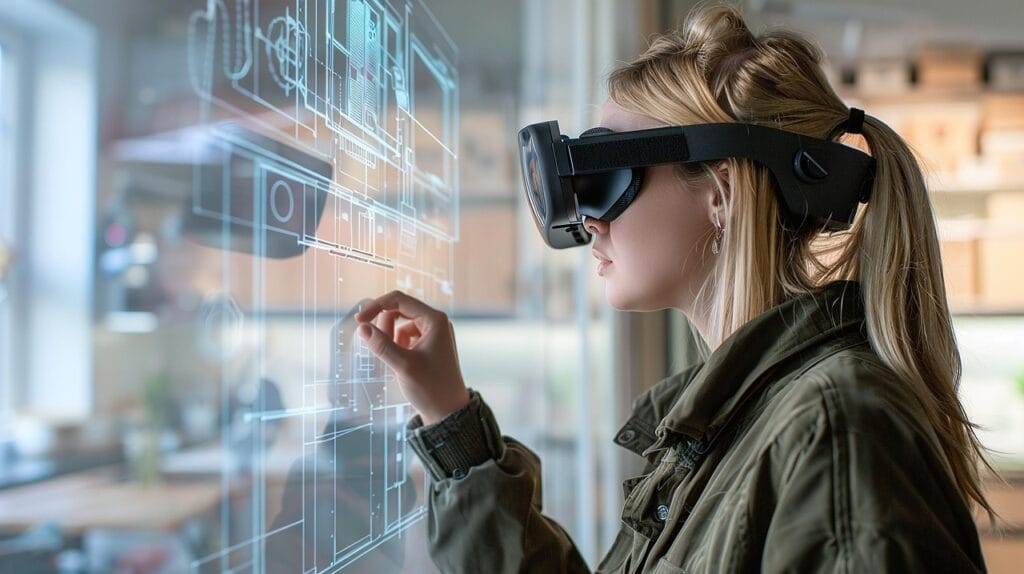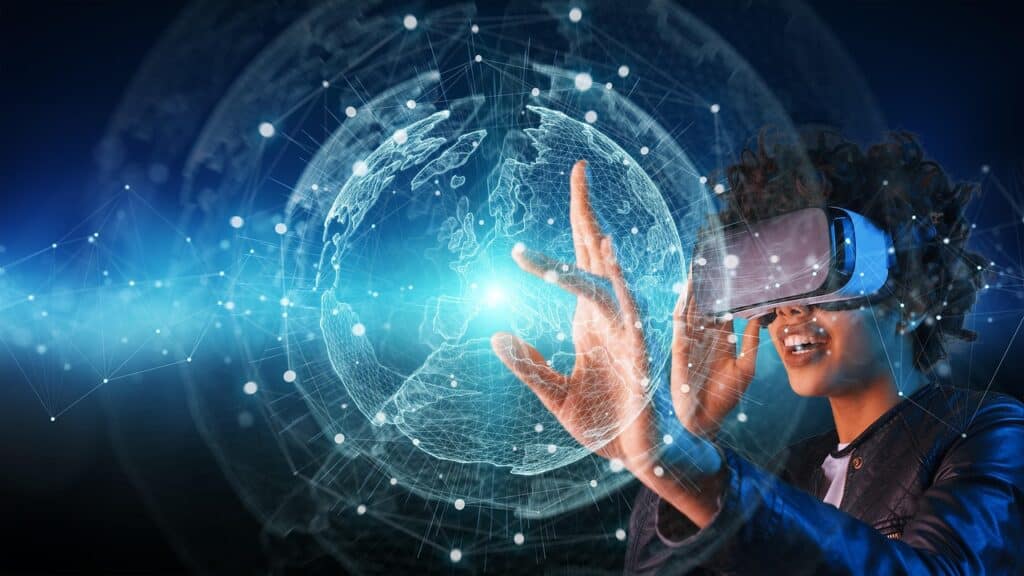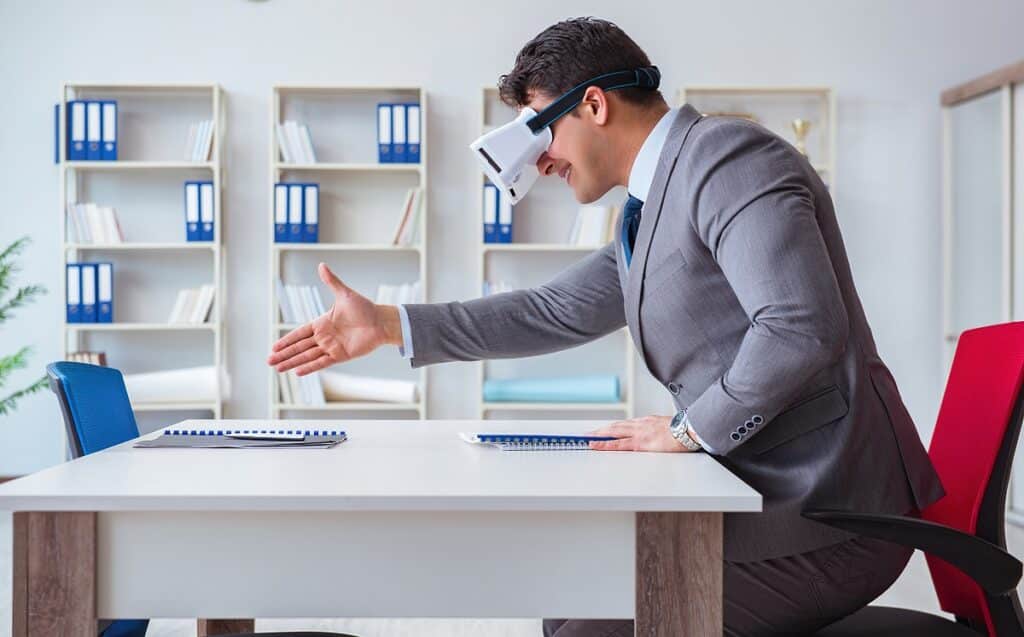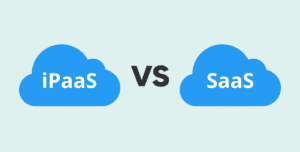Just like artificial intelligence, VR (Virtual Reality) is a new, ever-advancing technology that leaves no industry untapped for its use. VR has now become an essential part of skill development and training individuals, and enhancing their expertise in their respective domains. This blog takes you through VR integration and application in various sectors, like healthcare, armed forces, corporates, education, engineering & manufacturing, and soft skill development. We will also dive into the future and often-overlooked sections of VR.
What is Virtual Reality?
VR was initially most popular for gaming and entertainment and was largely perceived as confined to those areas. Virtual reality is a computer-generated stimulation technology that allows people to experience and interact with a 3D environment by wearing a VR headset and immersing themselves in an OT performing surgeries, fighting opponents in a game, or having a rollercoaster ride at a fun park. It can transport you to your desired reality.

Application & Real World Examples of VR Across Sectors
1. Military & Defence Training
- Combat simulations: Trainees are involved in battlefield situations, rescue missions, aerial dogfights, and urban warfare.
- Weapon training: Allows soldiers to master the weapon, its assembly, strike, and maintenance.
- Drone operation training & remote collaboration: VR enables remote piloting and reconnaissance mission training. Also supports intercountry joint exercises via VR networks.
Real-World Examples: US Army’s Synthetic Training Environment (STE), BAE Systems.
2. Healthcare & Medical Training
One of the most impactful applications of VR, it allows medical professionals to perform various medical procedures and tasks in a safe and risk-free environment, providing multiple scopes to practice for skill refinement.
- Surgical training: Medical students can perform surgeries multiple times, risk-free.
- Emergency response training: Enables paramedics and medical professionals to deal with situations like patient resuscitation, cardiac emergencies, and trauma cases.
- Empathy training: Allows medics to experience things from the patient’s perspective.
Real-World Examples: Osso VR, XRHealth, Oxford VR.
3. Education & Skill Development
- Virtual labs & immersive classrooms: Allow students to gain hands-on experimentation in science, chemistry, physics, and biology without the need for physical resources.
- Soft skill development: Roleplay stimulation encourages students to gain emotional intelligence.
- Spatial reasoning training: STEM learning enhances learning efficiency compared to traditional methods.
Real-World Examples: zSpace, VictoryXR, Labster.
4. Corporate Training
Figures from the PwC report suggested that the v-learners were up to 275% more confident, four times more focused & faster, and 3.75 times more emotionally connected than the e-learners.
- Leadership, management & team collaboration: Virtual offices and brainstorming sessions, with realistic role-playing scenarios including conflict resolution & decision making.
- Public speaking training
- Customer service training: Employees can engage with virtual consumers.
Real-World Examples: Accenture, Spatial.io, Arthur VR.
5. Engineering & Manufacturing
- Machine handling and safety drills: Technicians can handle heavy machinery without real risks, allowing them to troubleshoot, repair, and perform upgrade experiments.
- Process optimization: Testing lines virtually before handling actual units.
Real-World Examples: Boeing, Siemens, Porsche.
6. Aviation & Aerospace
- Pilot training & stimulation: Allows pilots to explore cockpits, enabling flight stimulations (like weather conditions, turbulence, emergency scenarios), and multiaircraft training.
- Maintenance: Aeroengineers and technicians can deep dive into the aircraft to inspect and repair through VR modules.
- Cabin crew training
Real-World Examples: CAE XR Series, Lufthansa Aviation Training, Boeing & Airbus, Japan Airlines (JAL), Emirates Aviation College.
7. Vocational & Skill-Based Training
- Hospitality Real-World Examples: Radisson Blu, Best Western, Marriott’s Teleporter Experience.
- Architecture Real-World Examples: SmartVizX, IKEA Place, Matterport.
- Tourism Real-World Examples: Thomas Cook VR, Marriott VR Postcards, Google Earth VR.
- Sports Real-World Examples: STRIVR, FitXR, Rezzil.

Advantages & Repercussions of VR
| Advantages Of VR In Skill Development | Barriers to VR In Skill Development |
| Immersive & Interactive Learning: Enables individuals to have a real-time experience and in-depth analysis of their respective job/task. For example, paramedics being able to perform surgery multiple times for practice is a significant advantage. | Health Concerns: Some people experience motion sickness, dizziness, and eye strain from using VR for prolonged hours. |
| Safe & Risk-Free Environment: Enables high-risk scenario practices without real-world scenarios and marginalizes accident risks. | Technical Limitations: VR is a high-power computing and a bit pricey technology, and not everyone has a compatible device or VR set, thus limiting its pervasive use. |
| Personalised & Adaptive Learning: Allows every individual to view and learn things from their own comfort and viewpoint. | High Initial Investment Cost: Setting up this technologically advanced training infrastructure requires a significant amount of budget to develop VR-compatible content, software & hardware. |
| Cost-Effective: Affordable and convenient mode of training as it cuts down cost for physical equipment, travel, and logistics in various industries. | Steep Learning Curve For Instructors & Learners: VR training requires specialised technical knowledge to operate and manage VR. Some learners may also initially resist VR training. |
| Faster Skill Attainment: 3D VR visuals are processed way faster than text, and learners remember 80% of what they do rather than 20% of what they learn. | Need For Constant Updates: Requires constant upgradation to keep up with market trends & industry standards. |
Untouched Insights of VR & Future of VR

Let’s dive into some not-so-common and emerging understandings of VR.
1. Technological Insights
- Cloud-Powered VR Training (Emerging)
- Foveated Rendering & Eye Tracking
- Multi-Sensory VR (Beyond Visual + Audio)
2. Psychological & Cognitive Insights
- Cognitive Overload in VR Training ( prolonged use of VR can cause digital fatigue and information overload)
- Neuroplasticity & Skill Retention
- VR-Induced Empathy Training (underrated but powerful)
3. Untapped Insights In Business & Operations
- Subscription-based VR Training Platforms
- Integration with LMS & HR Analytics (VR is now deeply integrating with learning management systems and HR dashboards for tracking).
4. Untouched Ethical & Legal Insights
- Legal Liability in VR Accidents (who is responsible for risk & mishaps during VR training)
- Biometric Data Privacy Concerns (VR gathers real-time data of movements, reflex actions, and eye movements.)
5. Emerging Futuristic Overlooked Understandings
- Carbon Footprint from VR Hardware (no one talks about e-waste from VR technology, energy-hungry GPUs, and manufacturing trash.)
- Developing hybrid AR-VR models (not many know but AR & VR, but there’s a high chance that AR & VR mixed ecosystems will dominate future learning.)
Conclusion
From the above detailed discussion about VR’s advantages and disadvantages, current and future insights, we can conclude that it’s undoubtedly incorporated advancement in the workplace and skill development across industries. Yes, the technology comes with its own pros and cons, but we can focus on bringing the most out of it and mitigating the drawbacks.
Related: What Is AI Companion? Its Features, Applications & Popular Examples
Related: Top 10 Blockchain Technology Trends For 2025








